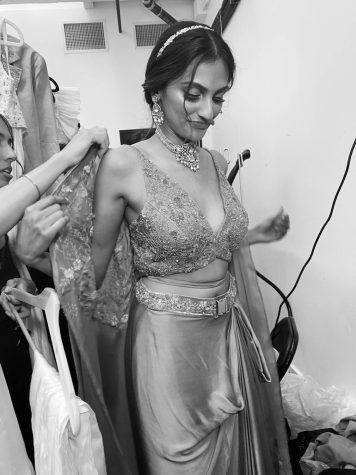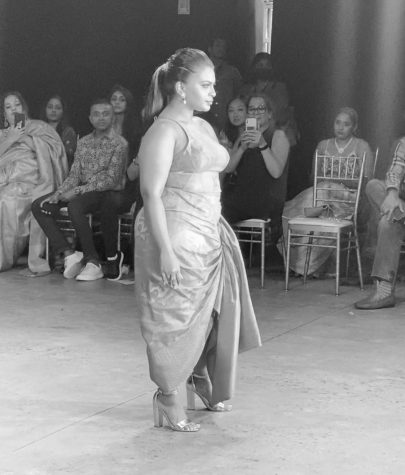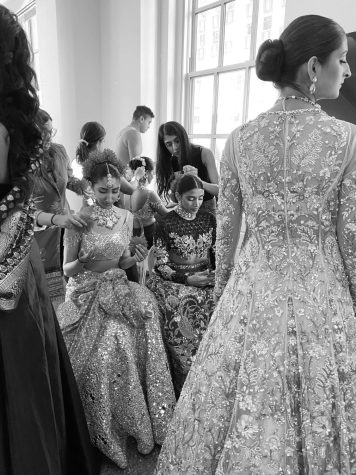Dissected Fairy Tale – Trinitonian

South Asia’s New York Fashion Week needs to do better to uplift marginalized cultures and designers within its own community
On September 7th, I flew to New York City for what I consider to be the brightest opportunity of my fashion career so far. I was selected to style the 1st South Asia New York Fashion Week (SANYFW). Up until this point, South Asian fashion had been given only a small division within New York Fashion Week. It was the first time the South Asian fashion community was able to host his week-long show and event dedicated purely to South Asian fashion. As an inexperienced college student, I was given the opportunity to participate in a groundbreaking project. SANYFW was as hard-working, fast-paced, and gorgeous as you can imagine. More than stepping into the modern fashion pool, attending Wall Street and Chelsea Factory shows, meeting Teen Vogue Editor-in-Chief Varsya Sharma, and other influencers I’ve followed over the years. I felt that I did
how did i get involved
I think I got this opportunity because it came from my South Asian community, a community that I took the initiative to reach out to. Through all platforms he contacted SANYFW and emailed his resume, cover letter and portfolio and soon he was able to get in touch with Hetal Patel, his COO of SANYFW. rice field. From there, I created his portfolio of sample looks styling the CEO and his COO. I spent three days thoroughly curating his portfolio and received an email from Hetal Patel the morning after I submitted it. She thinks I accurately capture their personal style, indicating that they want to pick me up. During the week, I worked with a variety of people, including designers, models, and make-up her artists. My role was fluid and self-directed. I went where I was needed and where I thought I could be most helpful.

Diversity issue
Many of the opportunities, such as internships and writing experience, were due to the South Asian community providing me with the experience and resources I needed. But when it comes to activism and the advancement of marginalized identities, this same community often hurts each other more than those outside the South Asian diaspora. is a long way off, but the South Asian fashion community lags even further. We are still confronted with beauty norms such as unrealistic body and color standards. Many subcultures remain underestimated, promoting to those outside our community that South Asian culture is North Indian culture and nothing more.
The legacy of colonialism creates this tension within our community. Western fashion, largely due to increased dialogue and media exposure in Western societies in the last few years, should take the initiative to create viable change regarding body inclusivity and inclusion of marginalized communities. , but the language is not very abundant in the South Asian region.
How can we expect colonialist-stricken countries not to focus on the most Eurocentric expressions of beauty? It is the responsibility of the South Asian community to do the internal work of SANYFW is the platform for doing so, destabilizing the inaccurate representation of our community through the lens of fashion. that was all. The complexity of the South Asian community wasn’t accurately reflected at Fashion Week this year.
toxic exclusivity
I learned the most in terms of observing the industry like a fly because I worked behind the scenes from morning until late at night. Everything swirled around me, including whispers of gossip as I steamed my lehenga and dressed up as a model.
Working behind the scenes on the Mayyur Girotra show, the team felt like they were working with Miranda Priestly, the North Indian version of The Devil Wears Prada. This trope works well for the fashion designers and movies of the early 2000s, when our society was not so socially aware, but the character of the “diva designer” is this of critical awareness and inclusivity. I spoke with one model who said she avoided eating all day because Mayyur Girotra didn’t like watching his models eat. The stylist I worked with said she was supposed to be a model, but Girotra only wanted models that were tall and thin. It was broken.
The pity is that this is not shocking. This is industry wide. If there are curves or short models on the runway, it tends to be interspersed between tall and skinny models. That’s what you see at the majority of luxury and couture brands during Fashion Week.
The luxury fashion industry still embodies the value that being thin and tall is the norm, and anything outside of this beauty standard continues to be a minority among the masses. had curvaceous, short, and dark-skinned models who were discarded as only deserving of these small brands. Large couture designers such as Nomi Ansari and Mayyur Girotra were selective in choosing the most Eurocentric models when smaller designers didn’t have the “privilege” to do so.Me at SANYFW Many people I spoke to dismissed it with a “what can you do?” Or “that’s the industry”.

top to bottom
In some ways there is truth in these statements. The fashion industry is a realm of hyper-capitalism, and in this day and age, getting out of the system that stifles marginalized communities and fully dedicating all resources towards better standards seems like a luxury for designers. It seems. Many who have stepped into the industry do not have the status or the funding to make decisions that promote inclusiveness standards.
SANYFW received backlash on TikTok over inclusivity standards. On Instagram Live, SANYFW CEO Shipra Sharma briefly explained the controversy. She said that many of the model submissions they received were from individuals who fit some beauty standards better than others, and that the majority of their submissions followed the Eurocentric beauty standards that dominated the industry. He said that he hinted that he was materializing. .
I believe this statement is honest and speaks to what management was working on. By recognizing that there is, I came to bear the social responsibility as a person entering this industry.
Leading the first-ever SANYFW means working with limited resources and taking on many roles. But there was a lot that could have been done in the early stages. SANYFW’s management team is primarily made up of North Indians and can only have a North Indian or non-resident Indian perspective on the South Asian experience. South Asians are not merely equal to Indians and North Indians. In the future, we expect to have other South Asian communities across the board join the executive team from regions such as South India, Nepal, Sri Lanka, Afghanistan, and the Indo-Caribbean countries.
We believe that having this inclusiveness at the top, where major decisions about models, designers and cultural events are made, will be more truly representative of the South Asian diaspora. I could only see the sides. Most were North Indian, with only one major Pakistani designer and one South Indian designer. As a South Indian Tamil, I don’t believe my culture, and many other marginalized cultures in South Asia, have been given the representation they need throughout South Asian fashion.

The future of South Asian fashion
Regarding the fashion landscape as a whole, SANYFW should be credited as the first fashion week pioneer to give the South Asian fashion industry a platform to be included in the fashion rhetoric of the Western world. Our community has worked hard to occupy this space, but there is still much more we can do. We now have a voice that can further amplify our employees and their artistry, and I hope that SANYFW will be able to harness this power to increase their representation in the future.











